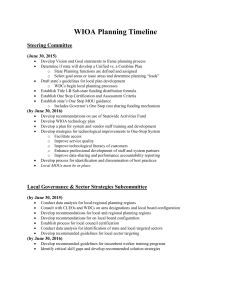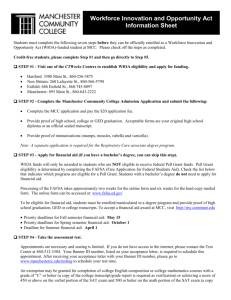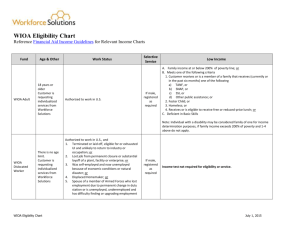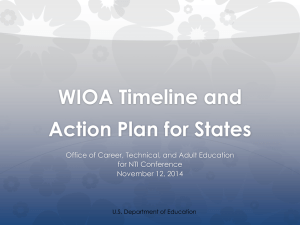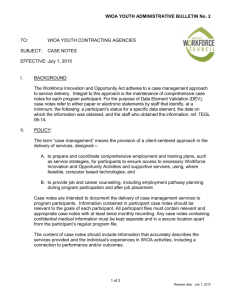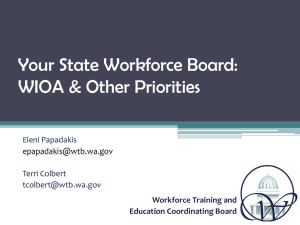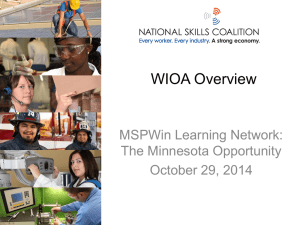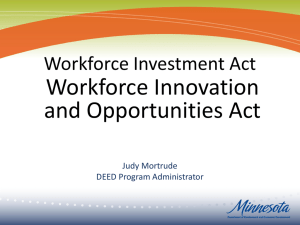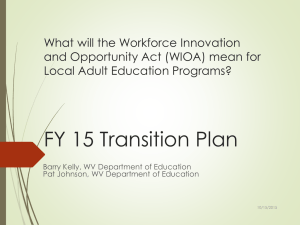Understanding Evaluation From Multiple Perspectives: Maximizing
advertisement
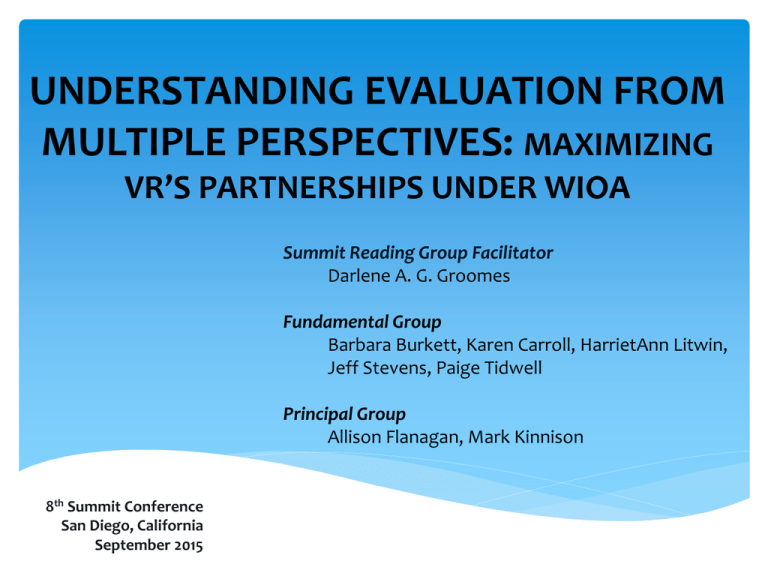
UNDERSTANDING EVALUATION FROM MULTIPLE PERSPECTIVES: MAXIMIZING VR’S PARTNERSHIPS UNDER WIOA Summit Reading Group Facilitator Darlene A. G. Groomes Fundamental Group Barbara Burkett, Karen Carroll, HarrietAnn Litwin, Jeff Stevens, Paige Tidwell Principal Group Allison Flanagan, Mark Kinnison 8th Summit Conference San Diego, California September 2015 SuRGE-6: SUMMIT READING GROUPS FOR EXCELLENCE • Represented seven states across the nation • Read Evaluation Roots: A Wider Perspective of Theorists’ Views and Influences by Marvin C. Alkin (2013) • Session PowerPoint and Presentation Takeaway Element will be available at: http://vocationalrehab.com/summit-reading-groups/projectdevelopment/ EVALUATION ROOTS: A WIDER PERSPECTIVE OF THEORISTS’ VIEWS AND INFLUENCES ALKIN (2013) Focused on three chapters with which SuRGE-6 members connected best: Enlightenment Sensemaking Getting People Involved Challenged by theoretical orientation; how to make information application-oriented? Connection to WIOA and its application in the changing environment Present: Regulations out January 2016 Future: As programs roll-out; performance reports and evaluations ADMINISTRATORS’ CONTEXT Utilizing partnerships to enhance performance and continuous improvement o Unified or Combined State Plan o Common performance measures o Dual-customer approach: Individual with a disability and employers o Accessibility o Services to groups o Funding Leveraging resources through program evaluation o Existing data within core partners o Streamlining ENLIGHTENMENT “The aim is to provide sound information that people in authority can use to make things better for the often disadvantaged people the serve.” Carol Hirschon Weiss Evaluators strive to work for the improvement of a program The three distinctive attributes of evaluation: It’s task- What type of interventions are being used, and how well do they function? It’s situation- Is it responsive to the desires and needs of program constituents? It’s mission- Is it helping society? ENLIGHTENMENT The Evaluator’s role as an expert on method Method is the main touchstone The method’s credibility offers the promise of unbiased and accurate information Policy makers and administrators want to learn about which programs and procedures stand the best chance of improving the lot of their people HOW TO ADDRESS UNDER WIOA • Emphasis on partnerships in the world of WIOA o How to align evaluation as a professional practice o How does VR maintain its mission while partnering with others? • Performance measures o The role of politics, and acknowledging the limits of evaluation o Staying relevant during all phases of evaluation o What will be measured? Closer look at rehab rates while at the same time emphasizing other measures such as activity in PETS. PERCEPTION…. ...is not always REALITY SENSEMAKING “Deliberate decision-making and action, informed by thoughtfully planned evaluation.” Melvin M. Mark and Gary T. Henry Social betterment as the guiding star • Values & well-being of others: Planning identifies what is most valued by the stakeholders & infuses into the evaluation; • Policy analytic: Planning involves awareness of the big & little picture, impact of evaluation, anticipated intended & unintended consequences; • Decision-making environment: Choosing method that has greatest impact on social betterment, decision making, and action. SENSEMAKING Alternative pathways of influence • Draw out the expected impact made by the evaluation • Sequence of influence, along with potential risks of interruption within the sequence • Identifies the purpose, condition of evaluation, and way to obtain meaningful information versus simply meeting requirements, Share findings in a way that connects with the natural “sense-making” processes of relevant stakeholders • Know the audience and intended users of the information • Get the most accurate answer to the most pressing question HOW TO ADDRESS UNDER WIOA Emphasis on partnerships in the world of WIOA As we work to put Americans with significant barriers to employment, back to work, evaluation planning identifies the multiple methods of valuing the partnerships required under the law. Questions could ask: What is the level of awareness among local staff of the various workforce programs that serve out of school youth? Why is this important? How would knowing level of awareness impact local or state agreements? How would information that has the greatest impact on putting youth to work be best captured ? HOW TO ADDRESS UNDER WIOA Performance measures Performance measure reporting, in itself, is not program evaluation. Shear numbers do not tell the story. That data, however, can be used to pose evaluation questions. Sense-making can help to prioritize: Questions if more than one surfaces The multiple methods of evaluation The consequences of the information learned, and How the information should be disseminated. Example: “Increasing self-sufficiency and prosperity of workers” (one of WIOA stated purposes and a public policy issue) As the guiding star in evaluation planning, this purpose could potentially assist in the development of a focused customer satisfaction survey for those who sought services for career advancement HOW TO ADDRESS UNDER WIOA Closer look at rehabilitation rate (Specific States Need to Show Percentage Increases by 2018) Difference between using evaluation as means to satisfy a reporting requirement and as a means to provide important information, which informs policy and decision-making. By using social betterment as a guiding star, evaluation activities can be narrow or broad, but all feed the over-arching need of this one question. Focus on WHY this information is important and how it contributes to the well-being of others, allows for the program evaluation activities to be built strategically and thoughtfully. GETTING PEOPLE INVOLVED “It was the users, not the report, who played a critical role in the evaluation process.” Jean A. King Employ “Utilization Focused Evaluation” Four key concepts The evaluator needs to facilitate usage of the evaluations in the agency Building evaluation capacity within the organization is important Interpersonal skills are crucial (communication, relationships, etc.) Evaluators need to teach participants (management and counselors) GETTING PEOPLE INVOLVED Michael Quinn Patton Process use (from Chapter 23) Draws attention to individual changes in thinking and behavior among those involved in the evaluation as a result of learning that occurs Helps those we work with learning to think evaluatively place value on specificity and clarity being systematic making assumptions explicit distinguishing inputs and processes from outcomes separating statements of fact from interpretation and judgments HELP PEOPLE THINK IN THESE WAYS; Learn how to learn, not just rely on a delimited set of findings HOW TO ADDRESS UNDER WIOA WIOA and good agency management require that evaluation findings be utilized for improvement of outcomes for both staff and clients Evaluate and ACT on trends in client outcomes to identify regions/counselors that may need assistance Evaluate and ACT on the current usage of PETS dollars to ascertain if this will be an issue for your agency Evaluate and ACT on resources and client population to avoid OOS Capacity building of evaluation will be essential as the need to examine agency needs increases HOW TO ADDRESS UNDER WIOA Good communication/interpersonal skills In order to set up fiscal/counselors’ tracking for PETS monies Communicate to staff and clients Order of Selection (OOS) policies and status Communicate the change in common measures so counselors and managers are cognizant of what is measured Why it is necessary Estimated time on the waiting list Procedures to take clients off the waiting list Teaching the findings and process of evaluation Teach common measures and how these are calculated to managers and staff so that they can track progress Have management and staff understand what led the agency to OOS and develop strategies to operate without this limitation PERFORMANCE MEASURES “Sanctions for states that fail to meet targets” Employment (2nd and 4th quarter accountability; retention) Earnings Credential attainment Measurable skill gains Serving employers These indicators add employment outcomes on earnings and effectiveness in serving employers, and include educational measures for credential attainment and skill gains. Workforce3 One Webinar: Session 4, Performance Accountability System (September 2014) WIOA Game Plan for Low-Income People: http://www.clasp.org/issues/postsecondary/wioa-game-plan ION https://wioa.workforce3one.org/page/about HOW AND WHY ALKIN (2013) PROMOTES ACCOUNTABILITY WITH THE INDICATORS Performance reports 10 reports required to inform on outcomes for core programs Level of performance for core programs Level of performance for individuals with barriers to employment (disaggregated) Total number of participants served Number of participants who received and exited career and training services within 3 years Average cost per participant for career and training services Percentage of participants who obtain unsubsidized employment in relevant field Number of individuals with barriers to employment served Number of participants co-enrolled Percentage of annual allotment spent on administrative costs Other information for program comparisons with other States Evaluations Promote continuous improvement, achieve high performance, achieve outcomes Fiscal and management accountability Promote efficient collection and use for reporting, monitoring, and preparing annual reports. Must have access to quarterly wage records and interstate arrangements EXAMPLE OF EVALUATION UNDER WIOA PARTNERSHIP * PLANNING * METHOD * IMPROVEMENT * VR MISSION Youth program elements across all workforce programs Financial literacy Entrepreneurial skills training Labor market services Transition to postsecondary education and training Education offered in same context as workforce preparation activities and training for occupation/cluster PETS Job exploration counseling Work-based learning experiences Counseling on opportunities for enrolling in postsecondary education Workplace readiness training Instruction in self-advocacy Other LEAD Center Webinar: Understanding changes regarding youth services, Part 3 (June 2015) GROUP DISCUSSION What are your experiences with PLANNING FOR EVALUATION and IMPROVEMENT under WIOA? State requirement for a unified approach Individual program planning approach (internal plans for integrity with PETS/Business) What action steps are you taking to ‘engage’ customers/obtain FEEDBACK-CONTINUOUS IMPROVEMENT in these busy times? What common TOOLS can be used to complete EVALUATION so that we have comparison across states? Pre-employment Transition Services (PETS) Order of Selection (OOS) Business Services Notes Posted on SG Website FOR MORE INFORMATION Darlene Groomes 248-370-4237 groomes@oakland.edu Summit Group Website www.vocational-rehab.com Three takeaway publications that can help your team to conceptualize working in partnership and striving to improve how and why these partnerships work: Evaluating Partnerships Collective Impact Evaluating Strategic Alliances To join a future reading group, visit: http://vocational-rehab.com/summit-reading-groups/
